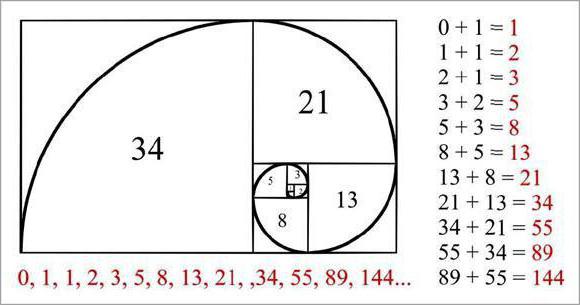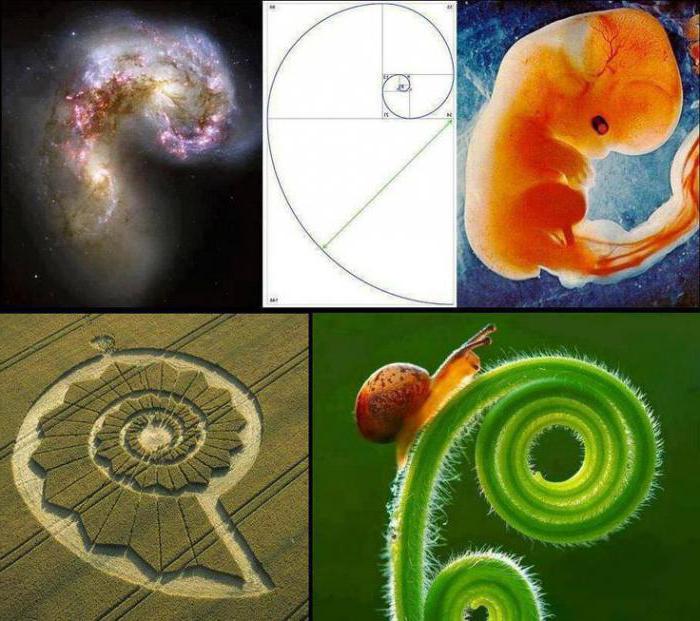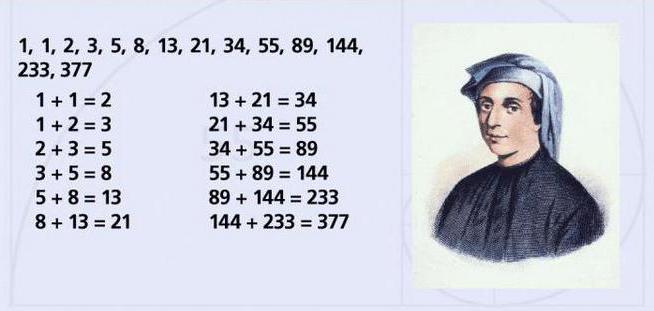There are still many unsolved mysteries in the universe,some of which scientists have already been able to identify and describe. The Fibonacci numbers and the golden section form the basis for deciphering the surrounding world, building its shape and optimal human perception with which it can sense beauty and harmony.
Golden ratio
The principle of determining the size of the golden sectionunderlies the perfection of the whole world and its parts in its structure and functions, its manifestation can be seen in nature, art and technology. The doctrine of the golden proportion was laid as a result of research by ancient scientists on the nature of numbers.
It is based on the theory of proportions andratios of divisions of segments, which was made by the ancient philosopher and mathematician Pythagoras. He proved that when a segment is divided into two parts: X (smaller) and Y (large), the ratio of the larger to the smaller will be equal to the ratio of their sum (of the whole segment):
X: Y = Y: X + Y.

The result is the equation: x2 - x - 1 = 0, which is solved as x = (1 ± √5) / 2.
If we consider the ratio 1 / x, then it is equal to 1.618 ...
Evidence of use by ancient thinkersthe golden proportions are given in Euclid’s book, The Beginning, written back in the 3rd century. BC, who applied this rule to construct a regular 5-gon. In the Pythagoreans, this figure is considered sacred because it is both symmetrical and asymmetrical. The pentagram symbolized life and health.
Fibonacci numbers
The famous book Liber abaci mathematics from ItalyLeonardo Pizansky, who later became known as Fibonacci, saw the light in 1202. In it, for the first time a scientist gives a pattern of numbers, in a row of which each number is the sum of the 2 previous digits. The sequence of Fibonacci numbers is as follows:
0, 1, 1, 2, 3, 5, 8, 13, 21, 34, 55, 89, 144, 233, 377, etc.
Also, the scientist cited a number of laws:
- Any number in the series, divided by the next,will be equal to the value that tends to 0.618. Moreover, the first Fibonacci numbers do not give such a number, but as you move from the beginning of the sequence, this ratio will become more and more accurate.
- If, however, divide the number of the series on the previous, the result will rush to 1.618.
- One number, divided by the next one, will show a value tending to 0.382.
The use of communication and the laws of the golden section, Fibonacci numbers (0.618) can be found not only in mathematics, but also in nature, in history, in architecture and construction, and in many other sciences.
Archimedes spiral and golden rectangle
Spirals, very common in nature, wereinvestigated by Archimedes, who even derived her equation. The shape of the spiral is based on the laws of the golden section. When it is unwound, it turns out the length to which the proportions and Fibonacci numbers can be applied, the increment of the step is uniform.
The parallel between the Fibonacci numbers and the goldthe section can be seen and having built a “golden rectangle”, whose sides are proportional, like 1.618: 1. It is constructed by moving from a larger rectangle to a small one so that the lengths of the sides will be equal to the numbers from the row. Building it can be done in reverse order, starting with a square "1". When connecting the corners of the lines of this rectangle in the center of their intersection is obtained Fibonacci spiral or logarithmic.

The history of the use of golden proportions
Many ancient monuments of EgyptThey were built using golden proportions: the famous pyramids of Cheops and others. The architects of ancient Greece used them extensively in the construction of architectural objects such as temples, amphitheatres, and stadiums. For example, such proportions were used in the construction of the ancient Parthenon temple, the Dionysos Theater (Athens) and other objects that became masterpieces of ancient architecture, demonstrating harmony based on mathematical laws.
In later centuries, interest in the golden sectioncalmed down, and the laws were forgotten, but again resumed in the Renaissance, along with the book of the Franciscan monk L. Pacioli di Borgo "Divine proportion" (1509). It was an illustration of Leonardo da Vinci, who secured the new name of the "golden section". Also, 12 properties of the golden proportion were scientifically proven, and the author talked about how it manifests itself in nature, in art, and called it "the principle of building peace and nature."
Leonardo's Vitruvian Man
Figure, which Leonardo da Vinci in 1492illustrated the book of Vitruvius, depicts the figure of a man in 2 positions with his hands apart. The figure is inscribed in a circle and square. This figure is considered to be the canonical proportions of the human body (male), described by Leonardo on the basis of studying them in the treatises of the Roman architect Vitruvius.
The center of the body as equidistant point from the endhands and feet is considered the navel, the length of the hands is equal to the height of a person, the maximum width of the shoulders = 1/8 height, the distance from the top of the chest to the hair = 1/7, from the top of the chest to the top of the head = 1/6, etc.

Since then, the figure has been used as a symbol showing the internal symmetry of the human body.
The term "Golden Section" Leonardo used todesignations of proportional relations in the human figure. For example, the distance from the belt to the feet relates to a similar distance from the navel to the crown, as well as growth to the first length (from the waist down). This calculation is done similarly to the ratio of the segments in the calculation of the golden proportion and tends to 1.618.
All these harmonious proportions are often used by artists to create beautiful and impressive works.
Studies of the golden section in the 16-19 centuries
Using the golden ratio and Fibonacci numbers,research work on the issue of proportions continue for more than one century. In parallel with Leonardo da Vinci, the German artist Albrecht Dürer also worked on the theory of the correct proportions of the human body. For this, he even created a special compass.
In the 16th century The work of astronomer I. Kepler, who first applied these rules to botany, was devoted to the question of the relationship between the Fibonacci number and the golden section.
The new "discovery" was waiting for the golden section in the 19th century.with the publication of "Aesthetic Research" German scientist Professor Zeisig. He elevated these proportions to an absolute and declared that they are universal for all natural phenomena. He carried out studies of a huge number of people, or rather their bodily proportions (about 2 thousand), which resulted in conclusions about statistically confirmed patterns in the ratios of different parts of the body: shoulder lengths, forearms, hands, fingers, etc.
Objects of art (vases,architectural structures), musical tones, dimensions when writing poems - all this Zeizig reflected through the lengths of segments and figures, he also introduced the term "mathematical aesthetics". After obtaining the results, it turned out that the Fibonacci series is obtained.

Fibonacci number and golden ratio in nature
In the plant and animal world there isthe tendency to form in the form of symmetry, which is observed in the direction of growth and movement. The division into symmetrical parts, in which the golden proportions are observed, is a pattern common to many plants and animals.
The nature around us can be described using Fibonacci numbers, for example:
- the location of the leaves or branches of any plants, as well as the distances are related to a number of given numbers 1, 1, 2, 3, 5, 8, 13 and further;
- sunflower seeds (scales on cones, pineapple cells), located in two rows on twisted spirals in different directions;
- the ratio of the length of the tail and the whole body of the lizard;
- egg shape, if you draw a line conventionally through its wide part;
- the ratio of the size of the fingers on the hand of man.

And, of course, the most interesting forms representspiraling snail shells, patterns on the web, wind movement inside a hurricane, a double helix in DNA and the structure of galaxies - all include a Fibonacci number sequence.
The use of the golden section in art
Researchers involved in the search for artexamples of the use of the golden section, explore in detail the various architectural objects and paintings. Famous are the famous sculptural works whose creators adhered to the golden proportions - the statues of Olympian Zeus, Apollo Belvedere and Athens Parthenos.
One of the works of Leonardo da Vinci - «PortraitMona Lisa "- for many years, is the subject of research scientists. They found that the composition of the work consists entirely of "golden triangles", combined together in a regular pentagon-star. All the works of da Vinci are evidence of how deep his knowledge was in the structure and proportions of the human body, thanks to which he was able to catch the incredibly mysterious smile of Gioconda.

The golden ratio in architecture
As an example, scientists studied the masterpieces of architecture created according to the rules of the "golden section": the Egyptian pyramids, the Pantheon, the Parthenon, the Cathedral of Notre-Dame de Paris, St. Basil's Cathedral, etc.
The Parthenon is one of the most beautiful buildings in the AncientGreece (5th century BC) - has 8 columns and 17 on different sides, the ratio of its height to the length of the sides is 0.618. The protrusions on its facades are made on the "golden section" (photo below).

One of the scientists who invented and successfullyapplied the improvement of the modular proportions system for architectural objects (the so-called "modulor"), - was the French architect Le Corbusier. The modulator is based on a measuring system associated with conditional division into parts of the human body.
Russian architect M.Kazakov, who built several residential buildings in Moscow, as well as the buildings of the Senate in the Kremlin and the Golitsyn Hospital (now the 1st Clinical Hospital named after NI Pirogov), was one of the architects who used the golden section laws in the design and construction.
Apply proportions in design
In the design of clothes, all fashion designers make new images and models taking into account the proportions of the human body and the rules of the golden section, although by nature not all people have perfect proportions.
When planning a landscape design and creatingvolumetric park compositions with the help of plants (trees and bushes), fountains and small architectural objects can also be applied to the laws of “divine proportions”. After all, the composition of the park should be focused on creating an impression on the visitor who can freely navigate in it and find the composition center.
All elements of the park are in such proportions that with the help of a geometrical structure, interposition, lighting and light, make a person the impression of harmony and perfection.
The use of the golden section in cybernetics and technology
Patterns of the golden section and Fibonacci numbersthey also manifest themselves in energy transitions, in processes that take place with elementary particles that make up chemical compounds in space systems, in the DNA gene structure.
Similar processes occur in the human body, manifested in the biorhythms of his life, in the action of organs, such as the brain or vision.
Algorithms and laws of golden proportionswidely used in modern cybernetics and computer science. One of the simple tasks that novice programmers give to solve is to write a formula and determine the sum of Fibonacci numbers to a certain number using programming languages.
Modern research on the theory of the golden proportion
Since the mid-20th century, interest in problems andthe influence of the laws of golden proportions on human life, increases dramatically, and from many scientists of various professions: mathematicians, ethnos researchers, biologists, philosophers, medical workers, economists, musicians, etc.
In the United States since the 1970s, the magazine begins to be issuedThe Fibonacci Quarterly, where papers are published on this topic. Works appear in the press in which the generalized rules of the golden section and the Fibonacci series are used in various branches of knowledge. For example, for coding information, chemical research, biological, etc.

All this confirms the conclusions of the ancient and modernscientists that the golden proportion is multilaterally connected with the fundamental questions of science and manifests itself in the symmetry of many creations and phenomena of the world around us.











